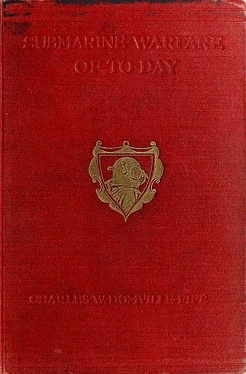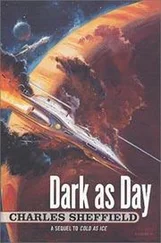Strictly speaking, were distinct divisions possible, the Tenth Cruiser Squadron did not form part of the auxiliary navy in its true sense, although many of the officers and men were drawn from newly raised corps. It acted rather as a distinct patrol fleet, filling the wide gap of sea between Scotland and the Arctic ice.
Next in order of importance came the newly built screw sloops, with powerful guns and engines. Their numbers varied and they were continually being added to. Some of these vessels were used for patrol duties and others for minesweeping. The sloop flotillas had many zones of activity. One was the North Atlantic, with special care for the coast of Ireland. Another was the North Sea, with a marked preference for the east coast of Scotland and the Straits of Dover.
These flotillas also were frequently assigned duties independent of the auxiliary patrol organisation, but nevertheless formed an important part of the vast anti-submarine and anti-mine navy.
In the Mediterranean also there were a number of patrol gunboats and minesweepers similar to the fighting sloops. Their principal base in this region was on Italian soil.
We now come to that portion of the auxiliary fleet whose special care was the seas around the United Kingdom and the Colonies. First came the armed yachts, over 50 in number, with tonnages varying from one to five hundred. These were obtained from the owners, armed as heavily as their size and strength permitted, and mostly became the flag-ships of patrol flotillas. They were nearly always equipped with wireless, hydrophone listening apparatus, depth charges and all the appliances for anti-submarine warfare.
Their losses were not heavy considering the dangerous nature of their work and could almost be counted on the fingers of both hands. This was due mainly to their good speed and manœuvring qualities. They made wonderfully efficient auxiliary warships, maintaining the sea in almost all weathers and accounting for quite a number of U-boats. These vessels were, of course, never used for the rougher work of minesweeping.
The whalers were few in number and resembled small destroyers. They were powerful craft and well armed, but their sea-keeping qualities left much to be desired. In fact, to use a naval term, they were dirty boats even in a “lop.” It was said that if an officer or man had been for long in one of these ships he was proof against all forms of sea-sickness. A big assertion, as even old sailors will admit—but they call it “liver.”
About the screw and paddle minesweepers little can be said beyond the fact that they numbered about 200 and performed some of the most dangerous work in the war. Many of them were old passenger steamers from the Clyde, Bristol Channel, Thames and south and east coast resorts, the famous Brighton Queen being, until her untimely end on a mine off the Belgian coast, one of their number. The loss among this class of ship was about 10 per cent.
By far the largest portion of the auxiliary patrol units consisted of armed and commissioned trawlers. Their numbers far exceeded 1000, and nearly half were used for the dangerous work of minesweeping. About a trawler little need be said, for beyond what can be seen in the accompanying illustrations there is little of interest until we come to the question of their curious arms and appliances, fit subjects for a special chapter.
A large number of these units were fitted with wireless and carried masked batteries of quick-firing guns. To give here their zones of operation would be to set out in detail not only the seas around the British Isles, but distant waters such as the Mediterranean and the White Sea. They had distinct duties to perform, which may be summed up as follows:—(1) minesweeping; (2) night and day patrols alone or in company over immense areas of sea; (3) convoy duty; and (4) fishery guard.
Their losses were heavy, both in ships and men, amounting to about 30 per cent. Many were the lonely sea fights engaged in by these vessels. A few will receive the praise they deserve and the remainder will rest content with the knowledge of duty done.
If numbers or losses were the dominant factors the armed drifters should be high in the list. There were engaged considerably over 1000 of these craft, and the losses amounted to about 20 per cent.
It may be necessary to inform some of my readers that a drifter is not necessarily a vessel that is content to start out on a voyage and rely on drifting to its destination, as its name implies. The term is derived from the drift nets used by these vessels for fishing in time of peace. They are, in almost all respects, small editions of the deep-sea trawler— minus the powerful steam-driven winch for hauling in the trawl nets.

Yachting Monthly
Some of the 550 Motor Launch Hulls being constructed on the Banks of the St. Lawrence River, Canada
For war purposes the holds of these, and many other types of auxiliary warships, were converted into officers’ cabins, or gun platforms for masked batteries. A few carried special nets in which to entangle the wily “Fritz.” Others had aboard special types of submarine mines, and one, commanded by the author, was used for the transport of wounded from Admiral Sir David Beatty’s flag-ship, H.M.S. Lion , after the Jutland fight.
These were, as might be expected, good sea boats, and carried out duties of great danger and value. Several hundred were fitted with wireless. Their zone of operations was far flung, extending from the Arctic Circle to the Equator. It was, however, in the unequal fights with German destroyers in the Straits of Dover and with Austrian torpedo boat destroyers in the Adriatic that they made a name for valour. In two of these engagements no less than six and fourteen drifters were sunk in a few minutes.
About the now famous motor launches, or “movies,” as they are called in the Service, much will be said in later pages. They numbered over 500, and, with but few exceptions, were a homogeneous flotilla of fast sea-going patrol boats, heavily armed for their size. Some idea of their appearance under varying conditions will be gained from a study of the illustrations.
They were all commanded by R.N.V.R. officers, whose training on H.M.S. Hermione and elsewhere has been described in an earlier chapter. They carried a crew of nine men and two officers, and their zones of operations extended from the icy seas which wash the Orkneys and Shetlands to the West Indies and the Suez Canal.
It may be of interest to give here an extract from the American journal, Rudder , showing how these vessels came into being. 3 3 Yachting Monthly and R.N.V.R. Magazine , August, 1917.
Although the hulls were constructed in Canada, and much of the assembling was also carried out on the banks of the St Lawrence, the engines came from the United States. It was to the organising ability of Mr Henry R. Sutphen, of the Electric Boat Company, New York, that the delivery of over 500 of these wonderful little craft in less than a year was due. Here is that gentleman’s story of the “M.L.” contract:
“It was in February, 1915, that we had our initial negotiations with the British Naval authorities. A well-known English shipbuilder and ordnance expert was in this country, presumably on secret business for the Admiralty, and I met him one afternoon at his hotel. Naturally the menace of the German submarine warfare came into discussion; we both agreed that the danger was a real one, and that steps should be taken to meet it.
Читать дальше













